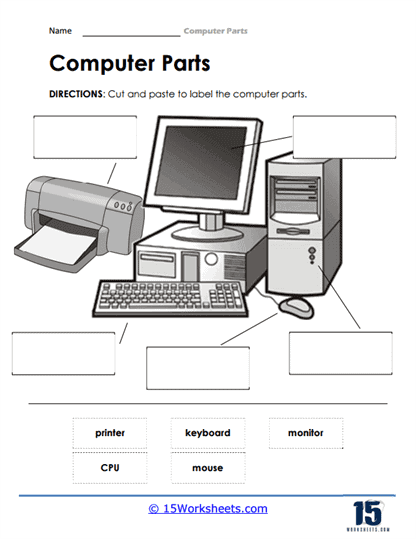Have you ever opened up your computer and stared at the intricate web of wires, circuits, and components, feeling completely lost? You’re not alone! Understanding the inner workings of a computer can be daunting, but it’s a valuable skill for anyone who wants to troubleshoot problems, upgrade their system, or simply gain a deeper appreciation for the technology that powers our lives. This article will serve as your comprehensive guide to internal computer parts, using the format of a common identification worksheet, helping you become a computer whiz in no time.

Image: www.pinterest.com
Remember that dreaded “identify the parts of a computer” worksheet from your tech class? We all had those moments of panic and confusion, desperately searching for the correct answers. But what if that worksheet was actually a door to a fascinating world of computer hardware? By understanding the functions of each component and how they work together, you’ll unlock a whole new level of understanding about your computer. So, let’s dive into the world of internal computer parts and conquer that worksheet (and any future computer-related challenges) with confidence!
Understanding the Anatomy of a Computer
Imagine the inside of your computer as a bustling city, where each component plays a crucial role in keeping everything running smoothly. We’ll start with the most prominent part, the **motherboard**. Think of this as the central nervous system, connecting all the other components and facilitating communication between them. It’s like the city’s main thoroughfare, with numerous lanes for data to flow through.
Next, we have the **CPU (Central Processing Unit)**, the brain of the operation. Located on the motherboard, it’s responsible for executing instructions and performing calculations, much like the city’s government headquarters directing all the essential activities.
Essential Components: The Core of Your Computer
The Powerhouse: The Power Supply Unit (PSU)
The PSU is the unsung hero of the computer world, providing the vital energy that keeps everything alive. It transforms the raw electrical current from your wall outlet into the specific voltages required by each component. Think of it as the city’s power plant, generating electricity to light up the city and keep everything running.

Image: seven.edu.vn
The Memory Banks: RAM (Random Access Memory)
RAM is like the city’s short-term memory, holding the data and instructions that the CPU needs to access quickly. It’s temporary storage, working like a scratchpad for the CPU’s ongoing tasks. When you open a program or a document, it temporarily resides in RAM until you close it, making it a crucial component for smooth performance.
The Data Vault: Hard Disk Drive (HDD) or Solid State Drive (SSD)
Your HDD or SSD is the long-term storage solution, like the city’s archives, storing your operating system, applications, and files for future use. HDDs use spinning disks to store data magnetically, while SSDs utilize flash memory for faster access times.
The Visual Gateway: The Graphics Card (GPU)
The GPU is the master of visuals, handling the complex calculations and processing needed to display images, videos, and games on your screen. It acts as the city’s entertainment center, bringing vibrant colors and smooth animations to your digital world.
Beyond the Basics: Expanding Your Knowledge
The Cooling System: Keeping it Cool
Computer components generate heat as they work, so a cooling system is vital to prevent overheating and potential damage. This usually involves a fan or heatsink attached to the CPU, as well as optional fans inside the case for better airflow. Think of it as the city’s air conditioning system, ensuring everyone stays cool and comfortable under pressure.
Storage Expansion: Optical Drives and External Storage
Optical drives (like CD and DVD readers) allow you to read and write information to discs, a technology that’s still relevant for software installation, data backup, or enjoying movies and music. External storage options, like USB drives or external hard drives, provide additional storage capacity for backing up your data or transporting files.
Troubleshooting and Optimization Tips
By understanding the functions of each component, you’re better equipped to diagnose issues and optimize your computer’s performance. If your computer is slow, it could be due to insufficient RAM or a malfunctioning hard drive. A noisy fan might indicate overheating or a failing component. Regularly cleaning out dust buildup inside the case can also improve airflow and extend the life of your components.
Consider upgrading your components for better performance. Replacing a traditional HDD with an SSD can significantly boost boot times and overall speed. Upgrading your GPU can enhance gaming capabilities and multimedia performance. Do your research and identify the best components for your specific needs and budget.
FAQs about Internal Computer Parts
Q: What are the best resources for learning more about computer parts?
A: Online forums like Tom’s Hardware, TechRadar, and Reddit’s r/buildapc are great sources for information and advice. You can also find tutorials on YouTube and websites dedicated to computer hardware.
Q: Can I replace or upgrade any computer part?
A: Most parts are replaceable. However, some components might be integrated into the motherboard, making them difficult or impossible to upgrade. Consult your motherboard’s manual for compatibility information.
Q: How often should I clean my computer?
A: It’s a good idea to clean your computer every few months, or more frequently if it’s in a dusty environment. Dust buildup can restrict airflow and cause overheating.
Internal Computer Parts Identification Worksheet Answers
Conclusion: Embark on Your Computer Journey
Understanding the internal parts of your computer is like unlocking a new world of possibilities. By knowing what each component does, you can troubleshoot problems, optimize performance, and even build your own computer from scratch! So, take the time to explore this fascinating topic and become a confident computer expert.
Are you interested in learning more about computer parts? Let us know your thoughts in the comments below! We are here to help you navigate the world of computer hardware and unlock your full computer potential!





